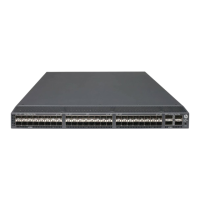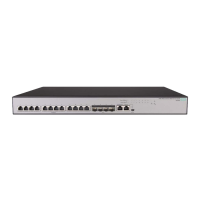135
slot slot-number: Specifies an IRF member device by its member ID or a PEX by its virtual slot
number. If you do not specify this option on an IRF fabric, the command displays fast forwarding
entries for the fragmented packets on all member devices. If you do not specify this option on an
eIRF system, the command displays fast forwarding entries for the fragmented packets on all parent
devices and PEXs.
Usage guidelines
This command displays fast forwarding entries for fragmented packets. Each entry includes the
source IP address, source port number, destination IP address, destination port number, protocol
number, input interface, and fragment ID.
Examples
# Display fast forwarding table information about all fragmented packets.
<Sysname> display ip fast-forwarding fragcache
Total number of fragment fast-forwarding entries: 2
SIP SPort DIP DPort Pro Input_If ID
7.0.0.13 68 8.0.0.1 67 17 InLoop0 2
8.0.0.1 67 7.0.0.13 68 17 M-GE0/0/0 3
Table 31 Command output
Field Description
SIP Source IP address.
SPort Source port number.
DIP Destination IP address.
DPort Destination port number.
Pro Protocol number.
Input_If
Input interface type and number.
If no interface is involved in fast forwarding, this field displays
N/A
.
If the input interface does not exist, this field displays a hyphen (-).
ID Fragment ID.
Related commands
reset ip fast-forwarding cache
ip fast-forwarding aging-time
Use ip fast-forwarding aging-time to configure the aging time of fast forwarding entries.
Use undo ip fast-forwarding aging-time to restore the default.
Syntax
ip fast-forwarding aging-time aging-time
undo ip fast-forwarding aging-time
Default
The aging time of fast forwarding entries is 30 seconds.

